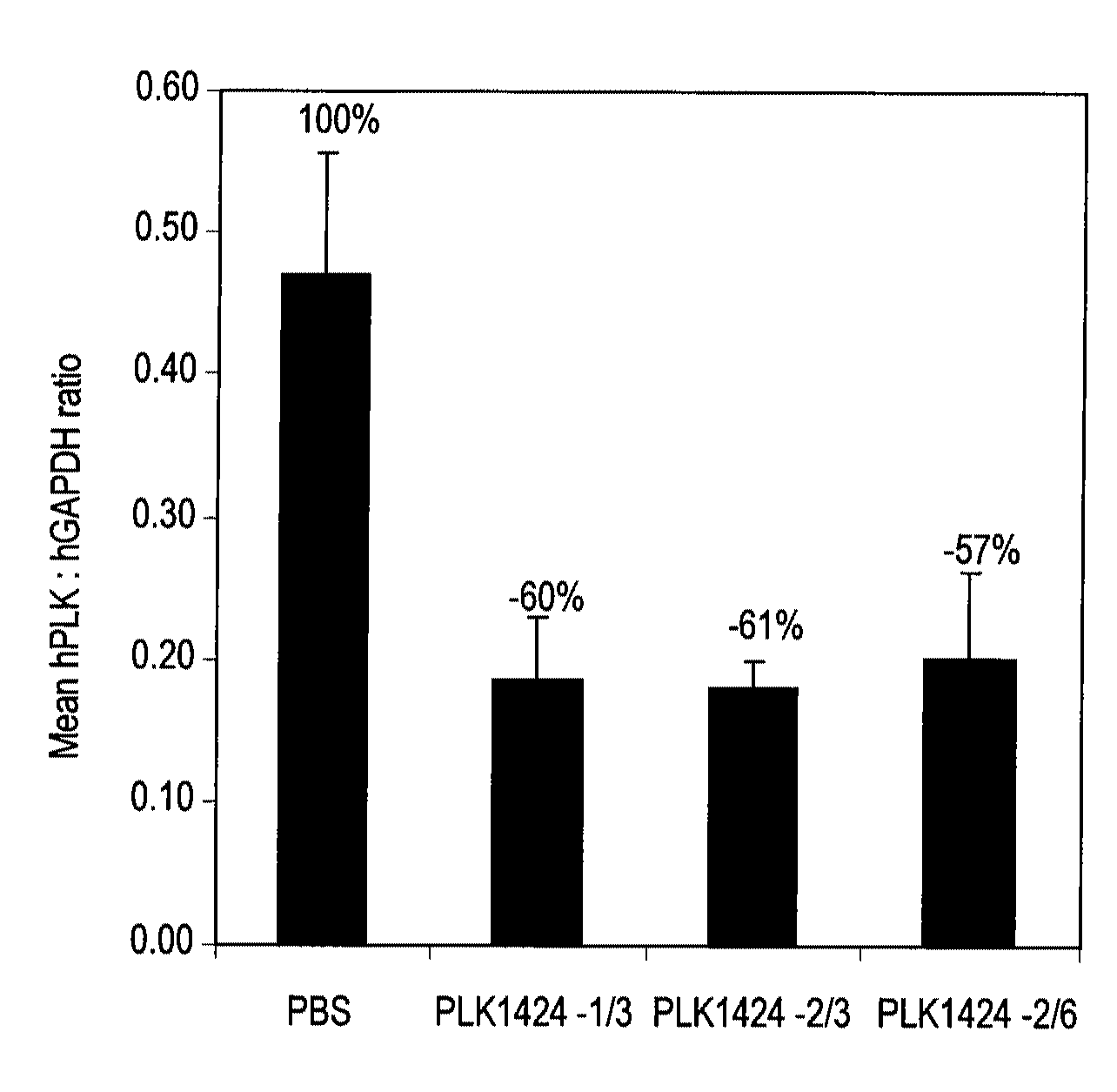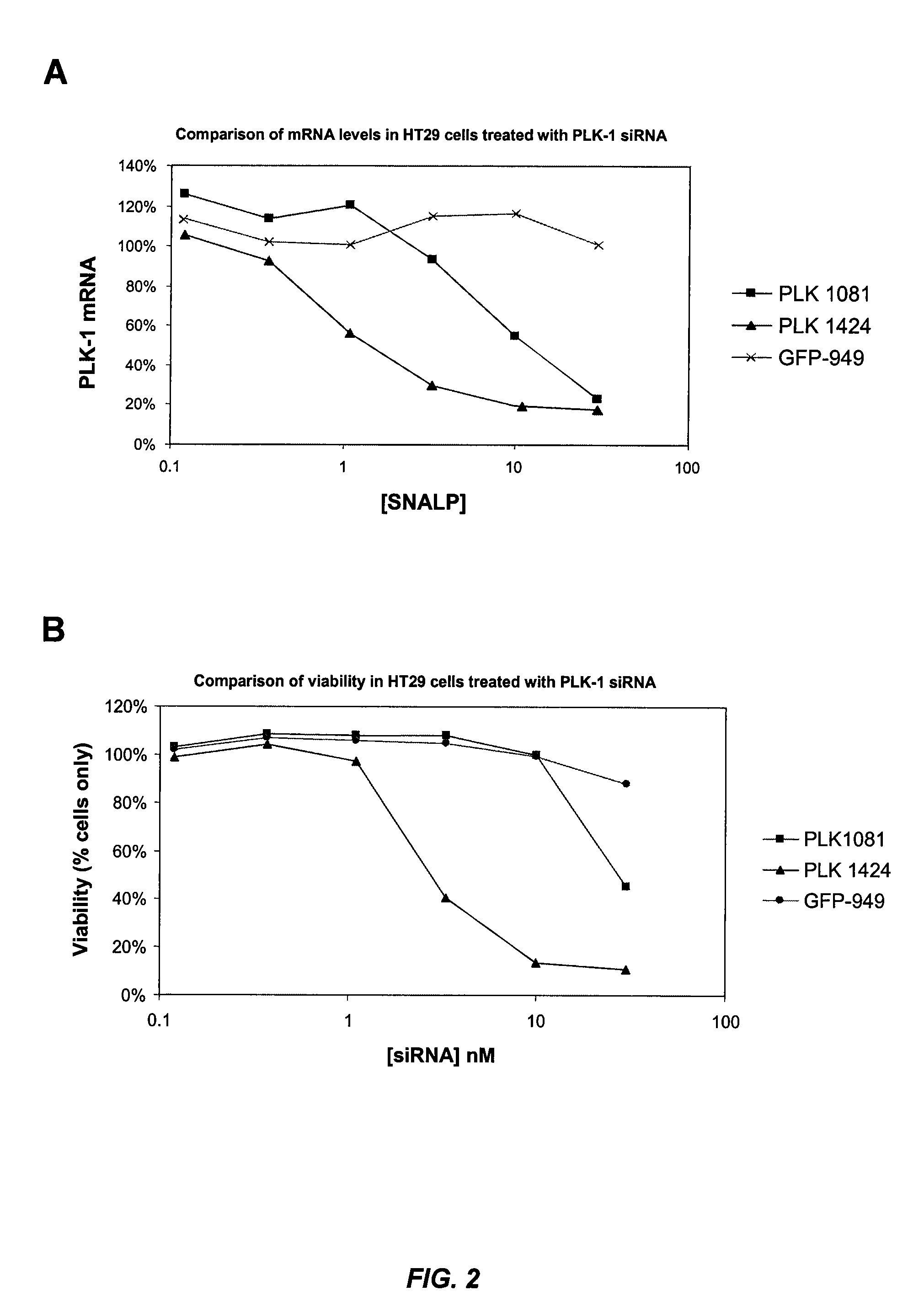Silencing of polo-like kinase expression using interfering RNA
- Summary
- Abstract
- Description
- Claims
- Application Information
AI Technical Summary
Benefits of technology
Problems solved by technology
Method used
Image
Examples
example 1
Materials and Methods
[0480]siRNA: All siRNA molecules used in these studies were chemically synthesized by the University of Calgary (Calgary, AB), Dharmacon Inc. (Lafayette, Colo.), or Integrated DNA Technologies (Coralville, Iowa). The siRNAs were desalted and annealed using standard procedures.
[0481]Lipid Encapsulation of siRNA: Unless otherwise indicated, siRNA molecules were encapsulated into nucleic acid-lipid particles composed of the following lipids: synthetic cholesterol (Sigma-Aldrich Corp.; St. Louis, Mo.); the phospholipid DSPC (1,2-distearoyl-sn-glycero-3-phosphocholine; Avanti Polar Lipids; Alabaster, Ala.); the PEG-lipid PEG-cDMA (3-N-[(-Methoxy poly(ethylene glycol)2000)carbamoyl]-1,2-dimyrestyloxy-propylamine); and the cationic lipid DLinDMA (1,2-Dilinoleyloxy-3-(N,N-dimethyl)aminopropane) in the molar ratio 48:10:2:40, respectively. In other words, unless otherwise indicated, siRNAs were encapsulated into liposomes of the following “2:40” SNALP formulation: 2% PEG...
example 2
Selection of Candidate PLK-1 siRNA Molecules
[0487]Candidate PLK-1 siRNA sequences were identified by imputing the human PLK-1 mRNA sequence (Genbank Accession No. NM—005030) or the mouse PLK-1 mRNA sequence (Genbank Accession No. NM—011121) into the Whitehead Institute for Biomedical Research siRNA design algorithm (see, e.g., Elbashir et al., Genes Dev., 15:188-200 (2001); Schwarz et al., Cell, 115:199-208 (2003); and Khvorova et al Cell, 115: 209-216 (2003); available at http: / / jura.wi.mit.edu / bioc / siRNAext / home.php). siRNA fulfilling the following criteria were selected: (1) NN(N19)NN target sequences; (2) thermodynamically less stable 5′ antisense end (Difference <−2.0); (3) G / C content between 30-70%; and (4) no four nucleotide stretches of the same base. Selected sequences were verified and the positions within both human and mouse target sequences were identified.
[0488]BLASTn searches against the human and mouse sequence databases were then performed on all selected sequences...
example 3
siRNAs Targeting PLK-1 Inhibit the Growth of Cancer Cells
[0492]Various PLK-1 siRNAs were formulated as SNALP (“2:40” SNALP formulation: 2% PEG-cDMA; 40% DLinDMA; 10% DSPC; and 48% cholesterol) and evaluated for their inhibitory effects on cell growth in vitro. HT29 (human colon adenocarcinoma) or Neuro2A (mouse neuroblastoma) cells were treated with various PLK-1 SNALP at a range of siRNA concentrations and their effect on cell viability was evaluated. Viability of cell cultures is expressed as % viability relative to PBS treated controls. FIG. 1A shows that SNALP containing PLK1424 were highly potent at killing human tumor cells. This siRNA sequence is specific to human PLK-1, as shown by its inactivity in the mouse cell line (FIG. 1B). SNALP containing either PLK1081 or PLK1345 also inhibited the growth of human tumor cells, but at higher siRNA concentrations (FIG. 1A). PLK1345, which was designed to be conserved between murine and human PLK-1, was effective at inhibiting the grow...
PUM
| Property | Measurement | Unit |
|---|---|---|
| Fraction | aaaaa | aaaaa |
| Composition | aaaaa | aaaaa |
| Length | aaaaa | aaaaa |
Abstract
Description
Claims
Application Information
 Login to View More
Login to View More - R&D
- Intellectual Property
- Life Sciences
- Materials
- Tech Scout
- Unparalleled Data Quality
- Higher Quality Content
- 60% Fewer Hallucinations
Browse by: Latest US Patents, China's latest patents, Technical Efficacy Thesaurus, Application Domain, Technology Topic, Popular Technical Reports.
© 2025 PatSnap. All rights reserved.Legal|Privacy policy|Modern Slavery Act Transparency Statement|Sitemap|About US| Contact US: help@patsnap.com



